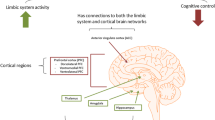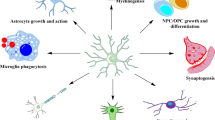Abstract
Inflammation recently has been considered to be participated in the pathogenesis of major depressive disorder (MDD). However, the detailed mechanism of inflammation in depression has not been completely understood yet. In the present study, depression mice model was established by chronic social defeat stress (CSDS) method and confirmed by behavior examinations including forced swimming test and sucrose preference test. The decrease of spine density and postsynaptic density protein 95 (PSD95) in hippocampus further verified the depression model. Then, the microglia polarization state and endoplasmic reticulum (ER) stress were investigated. At transcriptional level, M1 marker (inducible nitric oxide synthase (iNOS), CD16, CD86, CXCL10) in CSDS mice was higher than that in control group while there was no difference in M2 marker (Arginase and CD206) between two groups. And it was observed in the hippocampus of CSDS induced depression mice that increased activated microglia was merged with iNOS instead of arginase by immunofluorescence staining. Furthermore, the M1 marker Interleukin (IL)-1β and tumor necrosis factor (TNF)-α were increased in depression mice while the M1 marker IL-6 and M2 marker IL-10 remained unchanged. The expression of ER stress signaling factors, including protein kinase RNA-like ER kinase (PERK), Phosphorylated α-subunit of eukaryotic translation initiation factor 2(p-eIF2α), C/EBP homologous protein (CHOP), and X-box binding protein 1(XBP1) were significantly higher in CSDS-induced depression mice than in control mice. In all, our results suggest that M1 polarization and ER stress play a vital role in MDD pathogenesis.






Similar content being viewed by others
References
Ferrari AJ, Somerville AJ, Baxter AJ et al (2013) Global variation in the prevalence and incidence of major depressive disorder: a systematic review of the epidemiological literature. Psychol Med 43(3):471–481. https://doi.org/10.1017/s0033291712001511
Li N, Lee B, Liu RJ et al (2010) mTOR-dependent synapse formation underlies the rapid antidepressant effects of NMDA antagonists. Science 329(5994):959–964. https://doi.org/10.1126/science.1190287
Kang HJ, Voleti B, Hajszan T et al (2012) Decreased expression of synapse-related genes and loss of synapses in major depressive disorder. Nat Med 18(9):1413–1417. https://doi.org/10.1038/nm.2886
Duman RS, Aghajanian GK (2012) Synaptic dysfunction in depression: potential therapeutic targets. Science 338(6103):68–72. https://doi.org/10.1126/science.1222939
Hodes GE, Kana V, Menard C et al (2015) Neuroimmune mechanisms of depression. Nat Neurosci 18(10):1386–1393. https://doi.org/10.1038/nn.4113
Yirmiya R, Rimmerman N, Reshef R (2015) Depression as a microglial disease. Trends Neurosci 38(10):637–658. https://doi.org/10.1016/j.tins.2015.08.001
Wohleb ES, Franklin T, Iwata M et al (2016) Integrating neuroimmune systems in the neurobiology of depression. Nat Rev Neurosci 17(8):497–511. https://doi.org/10.1038/nrn.2016.69
Kohler CA, Freitas TH, Maes M et al (2017) Peripheral cytokine and chemokine alterations in depression: a meta-analysis of 82 studies. Acta Psychiatr Scand 135(5):373–387. https://doi.org/10.1111/acps.12698
Iwata M, Ota KT, Duman RS (2013) The inflammasome: pathways linking psychological stress, depression, and systemic illnesses. Brain Behav Immun 31:105–114. https://doi.org/10.1016/j.bbi.2012.12.008
Kohler O, Benros ME, Nordentoft M et al (2014) Effect of anti-inflammatory treatment on depression, depressive symptoms, and adverse effects: a systematic review and meta-analysis of randomized clinical trials. JAMA Psychiatry 71(12):1381–1391. https://doi.org/10.1001/jamapsychiatry.2014.1611
De Kock M, Loix S, Lavand’homme P (2013) Ketamine and peripheral inflammation. CNS Neurosci Ther 19(6):403–410. https://doi.org/10.1111/cns.12104
Bayer TA, Buslei R, Havas L et al (1999) Evidence for activation of microglia in patients with psychiatric illnesses. Neurosci Lett 271(2):126–128
Pan Y, Chen XY, Zhang QY et al (2014) Microglial NLRP3 inflammasome activation mediates IL-1beta-related inflammation in prefrontal cortex of depressive rats. Brain Behav Immun 41:90–100. https://doi.org/10.1016/j.bbi.2014.04.007
de Pablos RM, Herrera AJ, Espinosa-Oliva AM et al (2014) Chronic stress enhances microglia activation and exacerbates death of nigral dopaminergic neurons under conditions of inflammation. J Neuroinflammation 11:34. https://doi.org/10.1186/1742-2094-11-34
Franco R, Fernandez-Suarez D (2015) Alternatively activated microglia and macrophages in the central nervous system. Prog Neurobiol 131:65–86. https://doi.org/10.1016/j.pneurobio.2015.05.003
Tang Y, Le W (2016) Differential roles of M1 and M2 microglia in neurodegenerative diseases. Mol Neurobiol 53(2):1181–1194. https://doi.org/10.1007/s12035-014-9070-5
Golden SA, Covington HE 3rd, Berton O et al (2011) A standardized protocol for repeated social defeat stress in mice. Nat Protoc 6(8):1183–1191. https://doi.org/10.1038/nprot.2011.361
Shen J, Sheng X, Chang Z et al (2014) Iron metabolism regulates p53 signaling through direct heme-p53 interaction and modulation of p53 localization, stability, and function. Cell Rep 7(1):180–193. https://doi.org/10.1016/j.celrep.2014.02.042
Li C, Hu J, Li W et al (2016) Combined bortezomib-based chemotherapy and p53 gene therapy using hollow mesoporous silica nanospheres for p53 mutant non-small cell lung cancer treatment. Biomater Sci 5(1):77–88. https://doi.org/10.1039/c6bm00449k
Duman RS, Aghajanian GK, Sanacora G et al (2016) Synaptic plasticity and depression: new insights from stress and rapid-acting antidepressants. Nat Med 22(3):238–249. https://doi.org/10.1038/nm.4050
Grootjans J, Kaser A, Kaufman RJ et al (2016) The unfolded protein response in immunity and inflammation. Nat Rev Immunol 16(8):469–484. https://doi.org/10.1038/nri.2016.62
Qu Y, Yang C, Ren Q et al (2017) Regional differences in dendritic spine density confer resilience to chronic social defeat stress. Acta Neuropsychiatr. https://doi.org/10.1017/neu.2017.16
Yang C, Shirayama Y, Zhang JC et al (2015) Regional differences in brain-derived neurotrophic factor levels and dendritic spine density confer resilience to inescapable stress. Int J Neuropsychopharmacol. https://doi.org/10.1093/ijnp/pyu121
Xu W (2011) PSD-95-like membrane associated guanylate kinases (PSD-MAGUKs) and synaptic plasticity. Curr Opin Neurobiol 21(2):306–312. https://doi.org/10.1016/j.conb.2011.03.001
Beumer W, Gibney SM, Drexhage RC et al (2012) The immune theory of psychiatric diseases: a key role for activated microglia and circulating monocytes. J Leukoc Biol 92(5):959–975. https://doi.org/10.1189/jlb.0212100
Ramirez K, Niraula A, Sheridan JF (2016) GABAergic modulation with classical benzodiazepines prevent stress-induced neuro-immune dysregulation and behavioral alterations. Brain Behav Immun 51:154–168. https://doi.org/10.1016/j.bbi.2015.08.011
Ramirez K, Shea DT, McKim DB et al (2015) Imipramine attenuates neuroinflammatory signaling and reverses stress-induced social avoidance. Brain Behav Immun 46:212–220. https://doi.org/10.1016/j.bbi.2015.01.016
Nakagawa Y, Chiba K (2014) Role of microglial m1/m2 polarization in relapse and remission of psychiatric disorders and diseases. Pharmaceuticals 7(12):1028–1048. https://doi.org/10.3390/ph7121028
Steiner J, Walter M, Gos T et al (2011) Severe depression is associated with increased microglial quinolinic acid in subregions of the anterior cingulate gyrus: evidence for an immune-modulated glutamatergic neurotransmission? J Neuroinflammation 8:94. https://doi.org/10.1186/1742-2094-8-94
Xie W, Cai L, Yu Y et al (2014) Activation of brain indoleamine 2,3-dioxygenase contributes to epilepsy-associated depressive-like behavior in rats with chronic temporal lobe epilepsy. J Neuroinflammation 11:41. https://doi.org/10.1186/1742-2094-11-41
Muller N, Schwarz MJ, Dehning S et al (2006) The cyclooxygenase-2 inhibitor celecoxib has therapeutic effects in major depression: results of a double-blind, randomized, placebo controlled, add-on pilot study to reboxetine. Mol Psychiatry 11(7):680–684. https://doi.org/10.1038/sj.mp.4001805
Abbasi SH, Hosseini F, Modabbernia A et al (2012) Effect of celecoxib add-on treatment on symptoms and serum IL-6 concentrations in patients with major depressive disorder: randomized double-blind placebo-controlled study. J Affect Disord 141(2–3):308–314. https://doi.org/10.1016/j.jad.2012.03.033
Wiley JC, Meabon JS, Frankowski H et al (2010) Phenylbutyric acid rescues endoplasmic reticulum stress-induced suppression of APP proteolysis and prevents apoptosis in neuronal cells. PLoS ONE 5(2):e9135. https://doi.org/10.1371/journal.pone.0009135
Colla E, Coune P, Liu Y et al (2012) Endoplasmic reticulum stress is important for the manifestations of alpha-synucleinopathy in vivo. J Neurosci 32(10):3306–3320. https://doi.org/10.1523/jneurosci.5367-11.2012
Nevell L, Zhang K, Aiello AE et al (2014) Elevated systemic expression of ER stress related genes is associated with stress-related mental disorders in the Detroit Neighborhood Health Study. Psychoneuroendocrinology 43:62–70. https://doi.org/10.1016/j.psyneuen.2014.01.013
Zhang HY, Wang ZG, Lu XH et al (2015) Endoplasmic reticulum stress: relevance and therapeutics in central nervous system diseases. Mol Neurobiol 51(3):1343–1352. https://doi.org/10.1007/s12035-014-8813-7
Martinez G, Vidal RL, Mardones P et al (2016) Regulation of memory formation by the transcription factor XBP1. Cell Rep 14(6):1382–1394. https://doi.org/10.1016/j.celrep.2016.01.028
Abelaira HM, Reus GZ, Ignacio ZM et al (2017) Effects of ketamine administration on mTOR and reticulum stress signaling pathways in the brain after the infusion of rapamycin into prefrontal cortex. J Psychiatr Res 87:81–87. https://doi.org/10.1016/j.jpsychires.2016.12.002
Timberlake MA 2nd, Dwivedi Y (2015) Altered expression of endoplasmic reticulum stress associated genes in hippocampus of learned helpless rats: relevance to depression pathophysiology. Front Pharmacol 6:319. https://doi.org/10.3389/fphar.2015.00319
Kreisel T, Frank MG, Licht T et al (2014) Dynamic microglial alterations underlie stress-induced depressive-like behavior and suppressed neurogenesis. Mol Psychiatry 19(6):699–709. https://doi.org/10.1038/mp.2013.155
Meares GP, Liu Y, Rajbhandari R et al (2014) PERK-dependent activation of JAK1 and STAT3 contributes to endoplasmic reticulum stress-induced inflammation. Mol Cell Biol 34(20):3911–3925. https://doi.org/10.1128/mcb.00980-14
Li Y, Schwabe RF, DeVries-Seimon T et al (2005) Free cholesterol-loaded macrophages are an abundant source of tumor necrosis factor-alpha and interleukin-6: model of NF-kappaB- and map kinase-dependent inflammation in advanced atherosclerosis. J Biol Chem 280(23):21763–21772. https://doi.org/10.1074/jbc.M501759200
Acknowledgements
This study was supported by Grants from the National Natural Science Foundation of China (No. 81671151; No. 81371414).
Author information
Authors and Affiliations
Corresponding author
Ethics declarations
Conflict of interest
The authors declare that they have no conflict of interests.
Rights and permissions
About this article
Cite this article
Tang, J., Yu, W., Chen, S. et al. Microglia Polarization and Endoplasmic Reticulum Stress in Chronic Social Defeat Stress Induced Depression Mouse. Neurochem Res 43, 985–994 (2018). https://doi.org/10.1007/s11064-018-2504-0
Received:
Revised:
Accepted:
Published:
Issue Date:
DOI: https://doi.org/10.1007/s11064-018-2504-0




